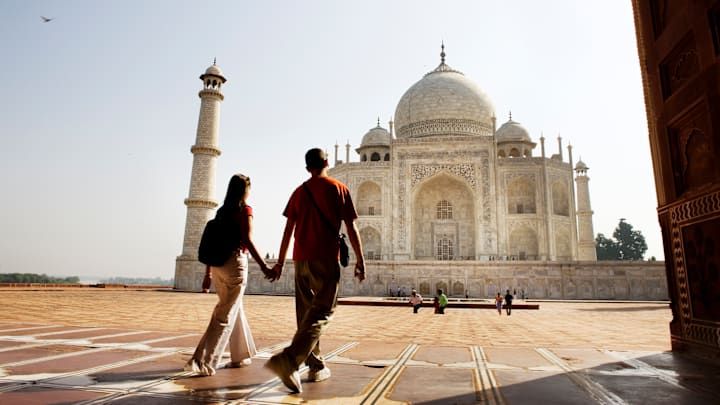Throughout history, hopeless romantics have been coming up with new ways to say “I love you”—and the most elaborate of these demonstrations go far beyond flowers and chocolates. A 190-carat diamond, and 18-minute symphony, and a marble mausoleum are some of the most over-the-top gifts given in the name of love. Whether you’re looking for inspiration for Valentine’s Day or you want to treat your sweetheart just because, these history-making romantic gestures should inspire you.
1. The Taj Mahal

The most iconic grand romantic gesture of all time has a tragic backstory. Arjumand Banu Begum—more commonly known as Mumtaz Mahal—become the third wife of Mughal emperor Shah Jahan in the 17th century. Though he had many wives, he considered Mahal his true love, and she bore him 14 children. Following her death during the birth of their last child, the grief-stricken Shah Jahan was inspired to build his late wife an elaborate tomb. Construction on the Taj Mahal began in 1632 and continued until 1653. In addition to Mahal’s grave (which is unadorned, per Muslim tradition), the grand memorial includes a mosque, gardens, and four 130-foot-tall minarets designed to fall away from the casket in case of collapse.
2. The Hanging Gardens of Babylon

Mystery surrounds this lost wonder of the ancient world, but according to legend, it was a gift from a king to his queen in the sixth century BCE. Nebuchadnezzar II’s wife Amytis hailed from Media, or the northwestern region of modern Iran. Wanting to please his homesick wife, the Babylonian king commissioned a project that would remind her of the mountains and flora of her native land. Historians believe the “hanging” gardens were actually terraces filled with greenery on a tiered structure. Without ruins or firsthand accounts to study, some experts question whether they were built in Babylon, or if they ever existed in the first place.
3. Richard Wagner’s “Siegfried Idyll”

The first six years of German composer Richard Wagner’s relationship to Cosima Liszt were marked by scandal. Both parties were married when they started their affair. Wagner’s first wife, Minna, died in 1866, and Cosima’s first husband, the conductor Hans von Bülow, allowed her to get divorced in 1870 after she had already given birth to three of Wagner’s children. Wagner and Cosima married as soon as possible. They were honeymooning when it came time to celebrate Cosima’s birthday on December 24, 1870. Wagner woke her in the morning with a chamber orchestra on the stairs of their Swiss villa performing a “symphonic birthday greeting” he had composed in secret. “Siegfried Idyll,” named for their son Siegfried, was filled with personal touches like family lullabies. Though it was conceived as a private gift for his wife, Wagner would later sell the 18-minute work and edit it to accommodate a larger orchestra.
4. Carl Sagan’s Dedication in Cosmos

Carl Sagan and Ann Druyan met at a party at Nora Ephron’s home in the 1970s, but their love blossomed while working on the golden record together. Druyan worked for NASA, and Sagan was helping her select the audio samples that would go on the gold-plated copper records being sent beyond the solar system as part of the Voyager mission. They were strictly friends for most of the project, but a single phone call took their relationship to the next level. Sagan had returned Druyan’s call to talk about an ancient Chinese song she had found for the collection, and by the end of the conversation they were engaged.
The astronomer and science writer declared his love for his wife in his most famous book. The poetic dedication in Cosmos reads: “For Ann Druyan: In the vastness of space and the immensity of time, it is my joy to spend a planet and an epoch with Annie.”
5. The Orlov Diamond

Grand romantic gestures aren’t always well-received. Count Grigory Orlov of Russia purchased a roughly 190-carat Indian diamond around 1774 with plans to give it to Catherine the Great. Their romantic affair had fizzled, and the count hoped to win her back with the expensive gift. Catherine rejected him (she was involved with Grigory Potemkin at that point) but still accepted the gemstome. She named the diamond after her former lover and had it fitted in the Imperial Scepter, which is now on display in the Kremlin Armoury in Moscow.
6. Edward VIII’s Abdication of the Throne

Edward VIII was willing to change British history to be with the woman he loved. After reigning as King of England for 11 months, the short-lived leader announced he was abdicating the throne in 1936 to marry twice-divorced American socialite Wallis Simpson. The implications of the gesture went far beyond their relationship: His brother Albert filled his place, making young Princess Elizabeth next in line for the crown. Though Wallis and Edward remained together until Edward’s death in 1972, their marriage didn’t always live up to its romantic beginnings, with affairs, public fights, and Nazi associations keeping them in the news.
7. Elizabeth Barrett Browning’s “How Do I Love Thee?”

Elizabeth Barrett and Robert Browning connected over their shared passion for poetry. After reading a poem of hers complimenting his work, Robert reached out to Elizabeth in a letter in 1845. He praised her talent, writing: “I do, as I say, love these books with all my heart—and I love you too.”
The pair exchanged over 500 letters before marrying nearly two years later. Their courtship is referenced in Elizabeth’s 1850 poetry collection Sonnets from the Portuguese, which the English poet dedicated to her husband. It contains the Petrarchan sonnet “How Do I Love Thee?”—her best-known work inspired by Robert Browning and one of the most famous love poems of all time.
